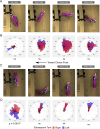Testing spatial working memory in pigs using an automated T-maze
- PMID: 38596242
- PMCID: PMC10913826
- DOI: 10.1093/oons/kvad010
Testing spatial working memory in pigs using an automated T-maze
Abstract
Pigs are an important large animal model for translational clinical research but underutilized in behavioral neuroscience. This is due, in part, to a lack of rigorous neurocognitive assessments for pigs. Here, we developed a new automated T-maze for pigs that takes advantage of their natural tendency to alternate. The T-maze has obvious cross-species value having served as a foundation for cognitive theories across species. The maze (17' × 13') was constructed typically and automated with flanking corridors, guillotine doors, cameras, and reward dispensers. We ran nine pigs in (1) a simple alternation task and (2) a delayed spatial alternation task. Our assessment focused on the delayed spatial alternation task which forced pigs to wait for random delays (5, 60, 120, and 240 s) and burdened spatial working memory. We also looked at self-paced trial latencies, error types, and coordinate-based video tracking. We found pigs naturally alternated but performance declined steeply across delays (R2 = 0.84). Self-paced delays had no effect on performance suggestive of an active interference model of working memory. Positional and head direction data could differentiate subsequent turns on short but not long delays. Performance levels were stable over weeks in diverse strains and sexes, and thus provide a benchmark for future neurocognitive assessments in pigs.
Keywords: declarative memory; navigation; spatial memory; translational neuroscience; working memory.
© The Author(s) 2023. Published by Oxford University Press.
Conflict of interest statement
The authors declare no competing financial interests.
Figures





References
-
- Aigner B, Renner S, Kessler Bet al. . Transgenic pigs as models for translational biomedical research. J Mol Med 2010;88:653–64 - PubMed
-
- Allen TA Automated Spatial and Nonspatial Memory Testing in Laboratory Pigs. Bethesda, MD: NIH/ORIP Workshop, Rigor and Reproducibility of Animal Studies: Extrinsic Factors Workshop, 2022
-
- Allen TA, Mattfeld AT, Draper A. Stereotaxic brain implant system for large animals. US Patent 10,251,722 (2019).
-
- Arts JWM, van der Staay FJ, Ekkel ED. Working and reference memory of pigs in the spatial holeboard discrimination task. Behav Brain Res 2009;205:303–6 ISSN 0166-4328 - PubMed
LinkOut - more resources
Full Text Sources
Miscellaneous
